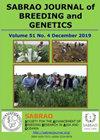ALGINATE BEADS UTILIZATION FOR LONG-TERM STORAGE OF MICROALGAL ISOLATES
IF 1.7
Q3 PLANT SCIENCES
引用次数: 0
Abstract
Microalgae reckon one of the most promising organisms due to their numerous applications in biotechnology, such as, their biomass utilization to extract various primary and secondary metabolites. These compounds benefit the food and pharmaceutical industries and the energy field, such as, biofuel and hydrogen gas production. Therefore, it is necessary to find various sustainable ways to actively preserve the isolates and productive strains with purity for an extended period without affecting their genetic characteristics and productive ability to grow and regenerate. The latest study aimed to compress several microalgae to form alginate beads using sodium alginate with five types of pure algal cultures, i.e., Scenedesmus quadricauda, Scenedesmus dimorphus, Chlorella vulgaris, Chlorococcum humicola, and Chlamydomonas sp. The vitality and activity of all the strains studied through the storage period showed the success of preparing alginate beads and staying viable for 18 months at 4 °C in the refrigerator under dark conditions. Therefore, encapsulating microalgae with sodium alginate is a possible and helpful method for preserving algae isolates for a prolonged period in a pure form. The survival of algae in alginate beads is an essential step to apply in the future as one of the viable methods to preserve pure algae isolates for a long time.藻酸盐珠在微藻分离株长期贮藏中的应用
微藻被认为是最有前途的生物之一,因为它们在生物技术中有许多应用,例如利用生物量提取各种初级和次级代谢产物。这些化合物有利于食品和制药行业以及能源领域,如生物燃料和氢气生产。因此,有必要找到各种可持续的方法,在不影响其遗传特性和生长再生的生产能力的情况下,长期有效地保持分离株和生产菌株的纯度。最新的研究旨在使用海藻酸钠将几种微藻与五种类型的纯藻类培养物(即四头藻Scenedesmus quadrauda、二形藻Scenedsmus dimorphus、小球藻Chlorella vulgaris、绿球藻Chlorococcum humicola和衣藻Chlamydomonas sp。在整个储存期内研究的所有菌株的活力和活性表明,成功地制备了海藻酸盐珠,并在黑暗条件下在4°C的冰箱中保持了18个月的活力。因此,用藻酸钠包裹微藻是一种可能且有助于以纯形式长期保存藻类分离物的方法。藻类在藻酸盐珠中的存活是未来应用的重要步骤,是长期保存纯藻类分离物可行的方法之一。
本文章由计算机程序翻译,如有差异,请以英文原文为准。
求助全文
约1分钟内获得全文
求助全文
来源期刊

Sabrao Journal of Breeding and Genetics
农林科学-奶制品与动物科学
CiteScore
1.90
自引率
50.00%
发文量
63
期刊介绍:
The SABRAO Journal of Breeding and Genetics is an international journal of plant breeding and genetics research and was first published in 1969. It is the official publication of the Society for the Advancement of Breeding Research in Asia and Oceania (SABRAO).
Its objectives are to: promote the international exchange of research information on plant breeding and genetics, by describing new research findings, or ideas of a basic or practical nature; and be a medium for the exchange of ideas and news regarding members of the Society.
The Journal gives priority to articles that are of direct relevance to plant breeders and with emphasis on the Asian region. Invited for publication are research articles, short communications, methods, reviews, commentaries, and opinion articles. Scientific contributions are refereed and edited to international standards.
The journal publishes articles for SABRAO members mainly. The Journal preferred strongly that at least one author should be a current member of the Society. Non-members may also publish in the journal.
 求助内容:
求助内容: 应助结果提醒方式:
应助结果提醒方式:


